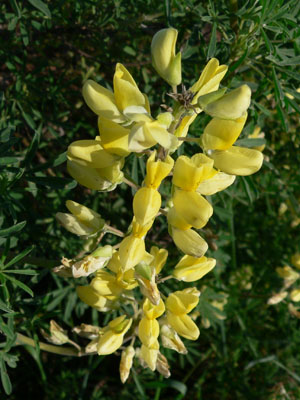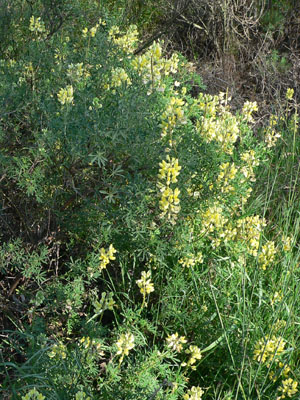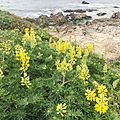Yellow bush lupine facts for kids
Quick facts for kids Yellow bush lupine |
|
|---|---|
 |
|
| Inflorescence of Lupinus arboreus | |
| Scientific classification | |
| Kingdom: | |
| (unranked): | |
| (unranked): | |
| (unranked): | |
| Order: | |
| Family: | |
| Subfamily: | |
| Tribe: | |
| Genus: | |
| Subgenus: | |
| Species: |
L. arboreus
|
| Binomial name | |
| Lupinus arboreus |
|
The Yellow Bush Lupine (also called Tree Lupin) is a beautiful flowering plant. Its scientific name is Lupinus arboreus. It belongs to the pea family, called Fabaceae. This plant is known for its bright yellow, pea-like flowers and its ability to grow in tough places.
Contents
Where Does the Yellow Bush Lupine Grow?
This shrub naturally grows in California. You can find it in areas with coastal sage scrub and on sand dunes. It is very common along the coast.
Scientists believe it originally grew from Point Reyes National Seashore down to San Luis Obispo County. However, because people have planted it in many places, its exact native area is a bit unclear.
What Does the Yellow Bush Lupine Look Like?
The Yellow Bush Lupine is an evergreen shrub. This means it keeps its leaves all year round. It can grow up to 2 m (7 ft) (about 6.5 feet) tall in protected spots. Usually, it is about 1–1.5 m (3–5 ft) (3 to 5 feet) tall.
This plant is quite tough. It can handle cold temperatures down to about -12°C (10°F). It can also live for up to seven years.
Its leaves are green to gray-green and look like a hand with fingers. Each leaf has 5 to 12 small leaflets. These leaflets are about 2–6 centimetres (0.79–2.36 in) (0.8 to 2.4 inches) long. They often have soft, silky hairs on them.
In spring, the plant produces many long clusters of flowers called racemes. These clusters can be 30 cm (12 in) (about 1 foot) long. The flowers are usually soft yellow and smell very nice, like peas. Sometimes, you can find forms with lilac or purple flowers, but the yellow ones are much more common.
Why Can This Plant Be a Problem?
Even though it's beautiful, the Yellow Bush Lupine can become an invasive species. This means it spreads outside its natural home and can harm other plants.
- Changing the Soil: Like many plants in the pea family, it helps put nitrogen into the soil. While this sounds good, it changes the soil chemistry. Native plants in these areas are used to low nitrogen levels. When the lupine adds nitrogen, other non-native plants can start to grow, pushing out the native ones.
- Mixing with Other Plants: The Yellow Bush Lupine can also hybridize (mix its genes) with other native lupine species. This can create new types of lupines that are not natural to the area. This mixing can make it harder for the original native lupine species to survive.
Because of these reasons, it has become an invasive plant in places like Southern California, the Pacific Northwest, British Columbia, western Europe, Australia, and New Zealand.
How People Use and Grow This Plant
The yellow-flowering Yellow Bush Lupine is very popular as an ornamental plant. People grow it in their gardens because of its pretty flowers. It's often used in traditional gardens, native plant gardens, and wildlife gardens.
It's also useful for stopping sand from drifting. Its roots help hold the sand in place on sand dunes. You might even see it growing in cracks in stone walls, which shows how well it can grow in places where water drains quickly.
This plant is so well-liked that it has won the Royal Horticultural Society's Award of Garden Merit.
Other Shrub Lupine Species
Besides the Yellow Bush Lupine, there are other types of lupines that also grow as shrubs:
- Lupinus chamissonis — Chamisso bush lupine, silver bush lupine
- Lupinus albifrons — Bush lupine
- Lupinus excubitus — Grape soda lupine
- Lupinus longifolius — Longleaf bush lupine
Images for kids



